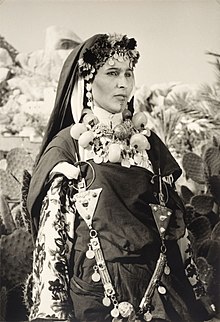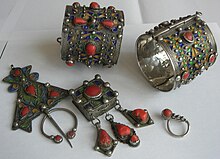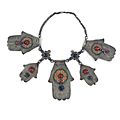Berber jewelry
The term Berber jewelry mostly silver - - jewelry in from different are Berbers inhabited country districts in the Maghreb states of Morocco , Algeria , Tunisia and Libya combined.
Historical and sociocultural background
Until well into the 20th century - in some cases even up to the present - had numerous Berber families a nomadic or semi-nomadic life ( transhumance ) and moved with their livestock (donkeys, sheep, goats, more rarely camels) in search of grazing land through the land . While settling down gradually began in the oasis valleys , survival in the drier regions (especially in the Anti-Atlas Mountains) was only possible if you had harvested barley , field beans , peas, etc., usually as early as March and April took place, with the cattle moved to the higher mountain regions of the High Atlas , where grasses, herbs and above all water were still available in sufficient quantities. They only returned to their native villages in late autumn; During the absence, the property was stored in communal warehouses ( Agadiren ) and defended against attacks by other nomads and hostile neighboring villages by a guards who stayed at home.
Jewelry, on the other hand, was easier to transport and was carried along by the women on the annual hikes. In a world that got by completely or largely without money, it played a certain role as a means of payment in emergency situations; therefore coins were more often soldered to necklaces, bracelets etc. - they could be broken off if necessary, but their value only consisted of the pure material value.
While the Arab and urban world of North Africa preferred gold jewelry , the Berbers clung to silver jewelry for centuries (perhaps even millennia). It can no longer be determined today whether this happened solely for economic or superstitious reasons, or whether it also concealed a deliberate cultural demarcation.
Jewellery
The often heavy and usually not very finely crafted Berber jewelry consists mainly of silver , which was generally said to have a beneficial effect ( baraka ); depending on the region also were coral , ivory and semi-precious stones applied. Typical forms of ornament are triangles and diamonds as well as the so-called ' hand of Fatima ', which have been assigned a disastrous ( apotropaic ) effect; they were also found in the ornaments of traditional mud or stone houses, over doors and on carpets, ceilings etc .; The tattoos of women or the henna ornaments applied on special occasions should also be mentioned in this context.
Ornaments were valued objects of value from the family inheritance and were passed on from one generation to the next. On this occasion, however, they were often reworked and supplemented - therefore pieces of jewelery can hardly be dated and one must assume that most of them were only made in the late 19th and early 20th centuries.
present
In the second half of the 20th century (semi) nomadism largely came to a standstill; Although health stations were gradually being set up in the rural regions of the Maghreb, the migration of the population from the countryside to the cities increased enormously. The Berber jewelry lost its original meaning and was sold to buyers traveling around for a small fee, who then sold it to the increasing number of antique shops in the cities; the numerous small shops along the main streets should also be mentioned in this context. Most of the end users are tourists, but most of the ethnographic museums in their home countries and in the rest of the world also present a number of pieces.
photos
Necklace with ' hands of Fatima '





